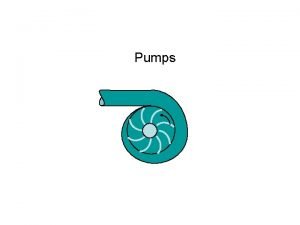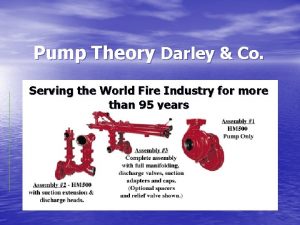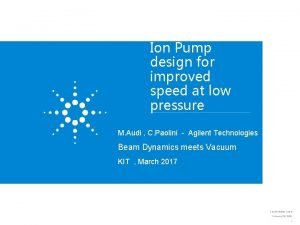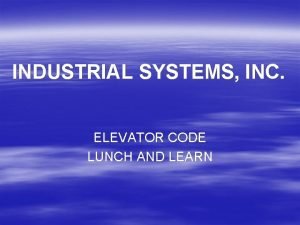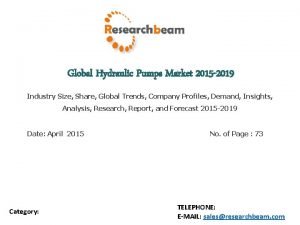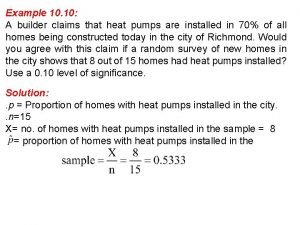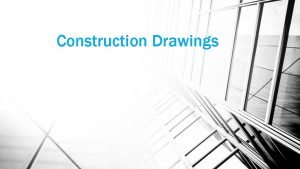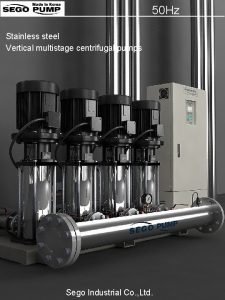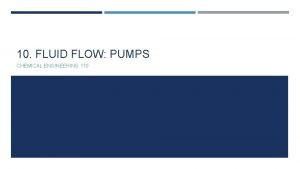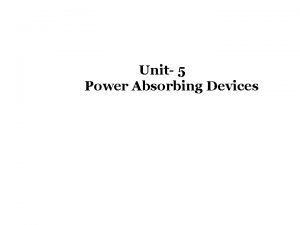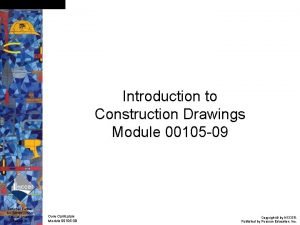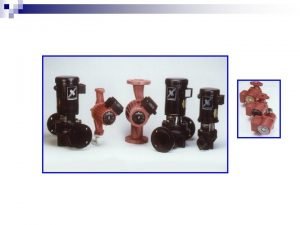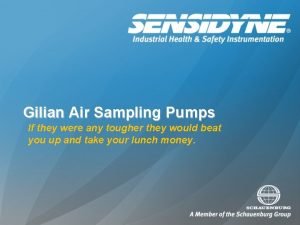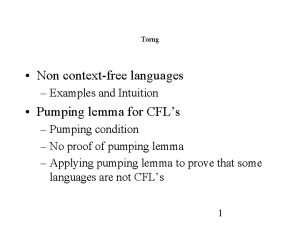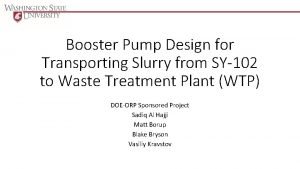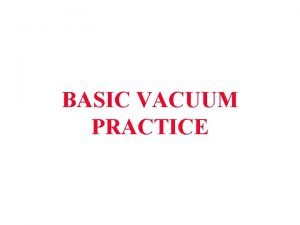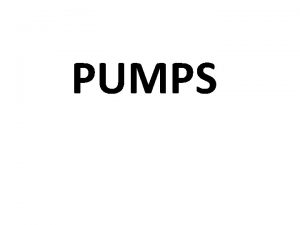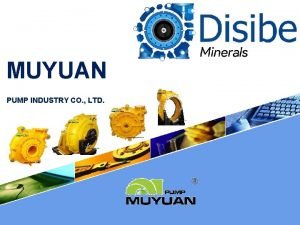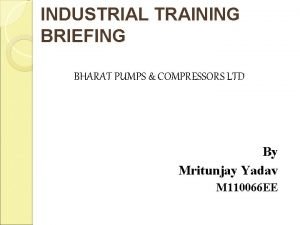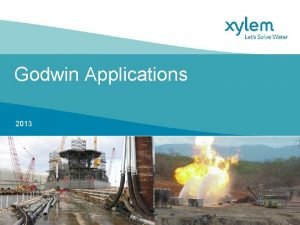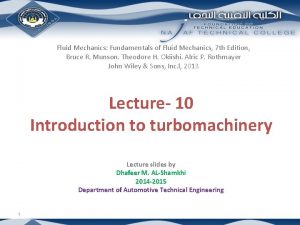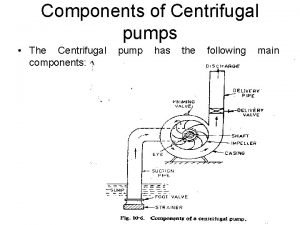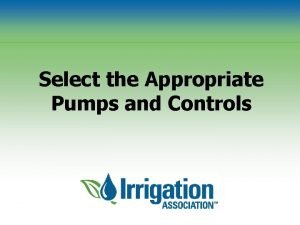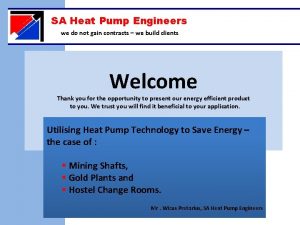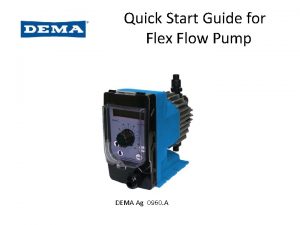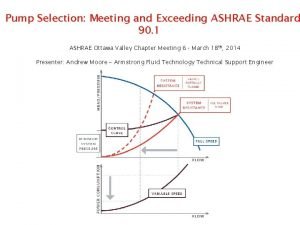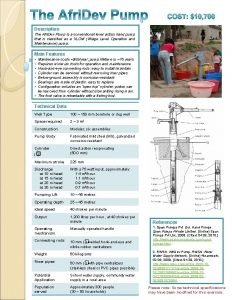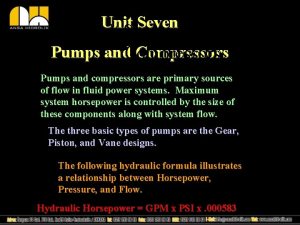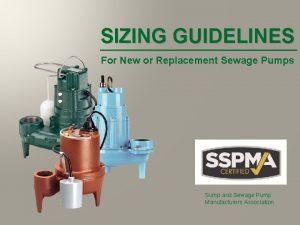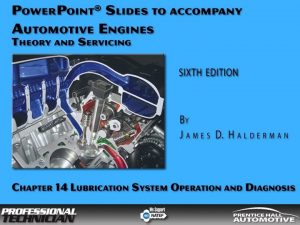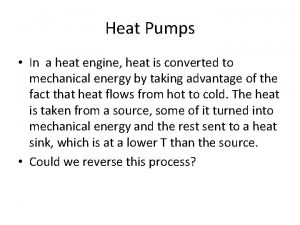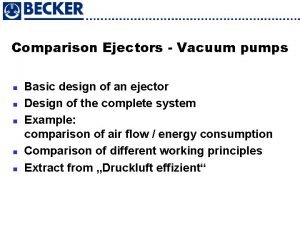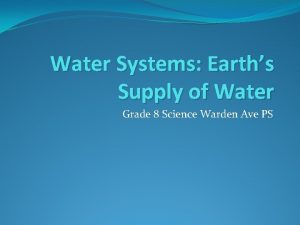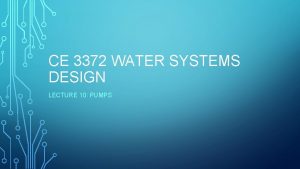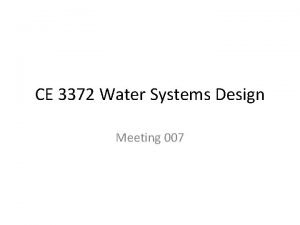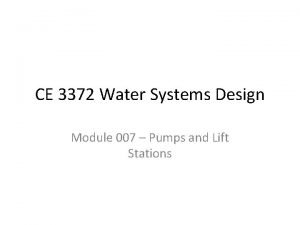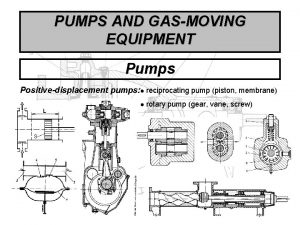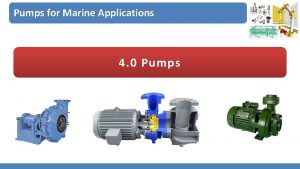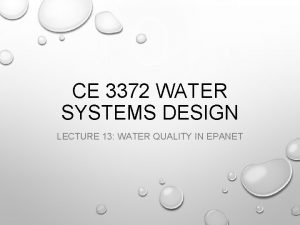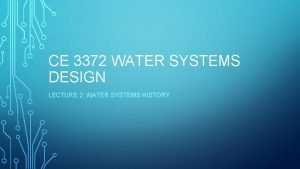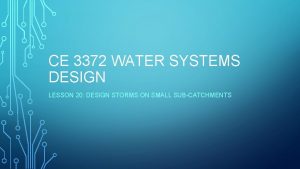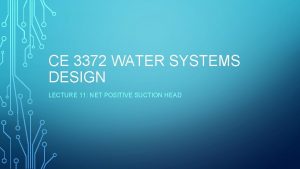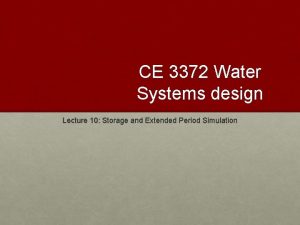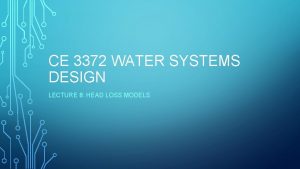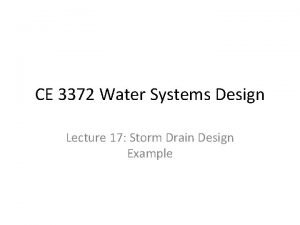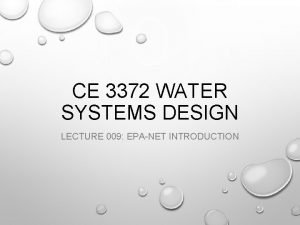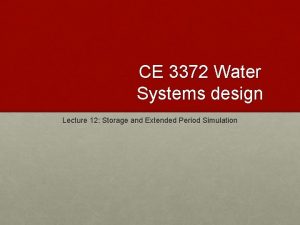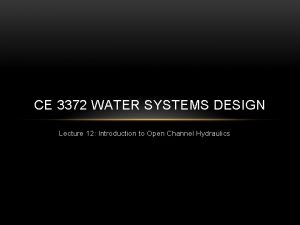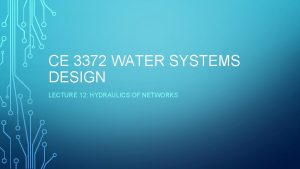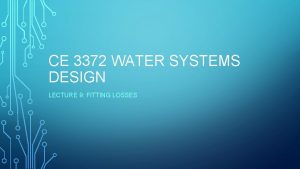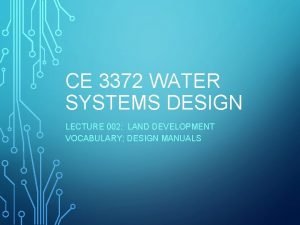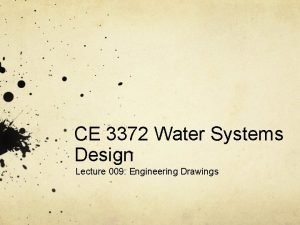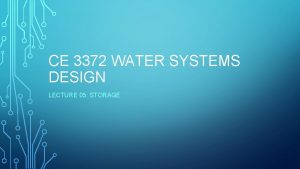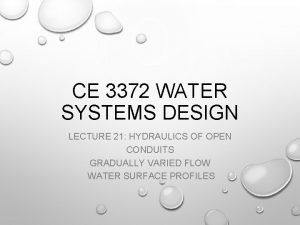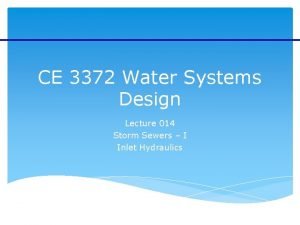CE 3372 WATER SYSTEMS DESIGN Lecture 06 Pumps
























































- Slides: 56

CE 3372 WATER SYSTEMS DESIGN Lecture 06 – Pumps and Lift Stations

Overview Review of EPA-NET lecture Valves Pumps Suction Requirements System and Pump Curves Lift Stations

Review The Project Game 1 st Place: +5% 2 nd Place: +4% 3 rd Place: +3% What is EPA-NET? How many Reservoirs? User Manual? Three main comp. to run EPA-NET?

Valves

Valves Devices which control amount and direction of fluid flow in closed conduit systems Bronze, brass, iron, or steel alloy

Types of Valves Stop Valves – Used to completely/partially shut off flow of fluid (ex: Check Valves – Used to permit flow in only one direction (ex: globe, butterfly, gate, plug, needle) ball-check, swing-check, lift-check) Special Valves relief, pressure-reducing, remote-operated

Globe Valve

Gate Valve

Butterfly Valve

Swing-check Valve

Pumps

Pumps A mechanical device that uses suction or pressure to to raise or move fluid lower to higher elevation


Pumps Positive Displacement Pumps Fixed volume of fluid is displaced each cycle regardless of static head/pressure Lower flow rates and higher head than non-positive pumps Non-Positive Displacement Pumps (Centrifugal etc. Pumps) Volume of fluid is dependent on static head/pressure

Pumps Positive Displacement Pumps Screw Pumps Reciprocating Pumps Non-Positive Displacement Pumps Centrifugal (Radial-Flow) Pumps Propeller Pumps (Axial-Flow) Jet Pumps (Mixed-Flow)

Positive Displacement Pumps Screw Pump A revolving shaft with blades rotates in a trough at an incline and pushes water up

Positive Displacement Pumps Reciprocating Pump A piston sucks the fluid into a cylinder and then pushes it out

Pumps Positive Displacement Pumps Screw Pumps Reciprocating Pumps Non-Positive Displacement Pumps Centrifugal (Radial-Flow) Pumps Propeller Pumps (Axial-Flow) Jet Pumps (Mixed-Flow)

Non-Positive Displacement Pumps Classification is based on the way water leaves the rotating part of the pump Radial-flow pump – water leaves impeller in radial direction Axial-flow pump – water leaves propeller in the axial direction Mixed-flow pump – water leaves impeller in an inclined direction (has both radial and axial components)

Radial-Flow Pumps Centrifugal Pump Accelerates water using an impeller Video Explanation Cool Video Discharge Suct ion ( Eye)

Axial Flow Pumps Axial flow pumps have impellers whose axis of rotation is collinear with the discharge Used in high flow, low head applications discharge suction

Suction Requirements

Suction Requirements The most common cause of pumping failure is poor suction conditions Cavitation occurs when liquid pressure is reduced to the vapor pressure of the liquid For piping system with a pump, cavitation occurs when Pabs at the inflow falls below the vapor pressure of the water

Suction Requirements Liquid must enter the pump eye under pressure; this pressure is called the Net Positive Suction Head available (NPSHa). A centrifugal pump cannot lift water unless it is primed the first stage impellers must be located below the static HGL in the suction pit at pump start-up

Suction Requirements The manufacturer supplies a value for the minimum pressure the pump needs to operate. This pressure is the Net Positive Suction Head required (NPSHr). For proper pump operation (w/o cavitation) NPSHa> NPSHr

Suction Requirements Available suction is computed from Frictional head loss in inlet piping Absolute pressure at liquid surface in suction pit Static elevation of the liquid above the pump inlet eye Absolute vapor pressure at liquid pumping temperature

Pressures Atmospheric pressure is pressure in the surrounding air at - or "close" to the surface of the earth. Absolute Pressure – is referenced to the pressure that would occur at absolute vacuum (0). 1 atm means it’s 1 atm MORE pressure than a perfect vacuum Gage Pressure – is referenced to “standard” atmospheric pressure. Varies with weather conditions and altitude above sea level. It’s MORE pressure than the Patm Pabs = Pgage + Patm

Suction Requirements Example

Suction Requirements Example

Suction Requirements Example

Suction Requirements Example

Suction Requirements Example

System and Pump Curves

Selecting Pumps Design conditions are specified Pump is selected for the range of applications A System Curve (H vs. Q) is prepared System Curve is matched to Pump Curve Matching point (Operating point) indicates the actual working conditions

System Curves A system (characteristic) curve is a plot of required head versus flow rate in a hydraulic system (H vs. Q) The curve depicts how much energy is necessary to maintain a steady flow under the supplied conditions Total head, Hp, = elevation head + head losses

System Curves

System Curves This relationship tells us that the added head has to be at least 30 meters just to keep the reservoirs at the two levels shown, if any flow is to occur the pump must supply at least 30+meters of head.

Pump Curves Provided information from the manufacturer on the performance of pumps in the form of curves. Information may include: discharge on the x-axis head on the left y-axis pump power input on the right y-axis pump efficiency as a percentage speed of the pump (rpm) NPSH of the pump

Pump Curves Provided d.

Pump Curves Provided information from the manufacturer on the performance of pumps in the form of curves. Information may include: discharge on the x-axis head on the left y-axis pump power input on the right y-axis pump efficiency as a percentage speed of the pump (rpm) NPSH of the pump

Pump Curves Operating Point Pump A cannot meet the needs of the system at any flow rate Pump B supplies enough head over part of the system curve The shaded area is the area where the pump supplies excess head


Pump and System Curves Pump Curve – How much energy the pump delivers to the water System Curve – How much energy it takes to deliver a flow rate to everyone in your distribution

How To Select a Pump Step 1 – Place system curves on chart (new and old) Step 2 – Select flow range (design requirements) High end = Peak Low = Avg. daily flow + fire Step 3 – Narrow down pumps based on operating point Step 4 – Check Efficiency! (75% +) and Select Pump Step 5 – If below 75%, try again with new Pump Curves

System Curve when OLD System Curve at NEW standards

Multiple Pumps Series and parallel combinations can be used to adjust “pump curves” to fit system requirements. Parallel pumps add flow for given head Series pumps add head for given flow


H 3 H 1 2 H 1 H 1 Three pumps in series Two pumps in series Single pump H 1 Q Q 1

Lift Stations!

Lift Stations Lift wastewater/stormwater to higher elevations when: discharge of local collection system lies below regional conveyance terrain or man-made obstacles do not permit gravity flow to discharge point.

Pond and Pump Station

Types of Lift Stations Submersible Lower initial cost Lower capacity Smaller footprint Wet-well / dry-well Higher initial cost Easier inspection/ maintenance

Submersible lift station

Wet-well / dry-well lift station

Design criteria Size the pumps and the wet-well (sump) storage capacity to accommodate inflow variability and detention time limits. Match the pumps to the flow and head requirements. Provide ‘near-absolute’ reliability Automated controls Redundant systems Alarms Regularly scheduled, preventive maintenance Assess and mitigate environmental factors Flood risk, noise pollution, visibility

Site plan and facilities Protected and accessible during a major flood Redundant power supplies Intruder-resistant with controlled access
 Rfc 3372
Rfc 3372 Water and water and water water
Water and water and water water 01:640:244 lecture notes - lecture 15: plat, idah, farad
01:640:244 lecture notes - lecture 15: plat, idah, farad Operating system lecture notes
Operating system lecture notes Lecture sound systems
Lecture sound systems Lecture sound systems
Lecture sound systems Radial flow centrifugal pump
Radial flow centrifugal pump Darley pump packing
Darley pump packing Ion pumps in the pumping speed range 150 to 1000 l/s
Ion pumps in the pumping speed range 150 to 1000 l/s Stancor elevator sump pump
Stancor elevator sump pump Global hydraulic gear pump market
Global hydraulic gear pump market A builder claims that heat pumps are installed in 70
A builder claims that heat pumps are installed in 70 Plans used for work that has to do with construction
Plans used for work that has to do with construction Sego pump
Sego pump Pumps in chemical engineering
Pumps in chemical engineering Work absorbing device example
Work absorbing device example Intro to construction drawings
Intro to construction drawings Effluent pumps haiti
Effluent pumps haiti Centrifugal pumps basics
Centrifugal pumps basics Gilian 800i air sampling pump
Gilian 800i air sampling pump Intuition pumps examples
Intuition pumps examples Flowserve distributors
Flowserve distributors Flo fab pumps
Flo fab pumps Maxp series pumps
Maxp series pumps Vacuum pumps
Vacuum pumps Factors for selection of pumps
Factors for selection of pumps Muyuan pumps
Muyuan pumps Bharat pumps & compressors ltd
Bharat pumps & compressors ltd Xylect australia
Xylect australia Fundamentals of fluid mechanics
Fundamentals of fluid mechanics Centrifugal pump components
Centrifugal pump components Pumps and controls
Pumps and controls Sa heat pump engineers
Sa heat pump engineers Dema ag
Dema ag Affinity law
Affinity law Afri pumps
Afri pumps Brunsdon pumps
Brunsdon pumps Seven pumps
Seven pumps Sliding shoe pump
Sliding shoe pump Sewage pump sizing
Sewage pump sizing Vehicle mounted pump
Vehicle mounted pump Two technicians are discussing oil pumps
Two technicians are discussing oil pumps Heat engine
Heat engine Vaccum pump working
Vaccum pump working Practical design to eurocode 2
Practical design to eurocode 2 Elemen urban design
Elemen urban design Elements and principles of design ppt
Elements and principles of design ppt Lecture hall acoustics
Lecture hall acoustics Game design lecture
Game design lecture Computer aided drug design lecture notes
Computer aided drug design lecture notes Cmos vlsi design lecture notes
Cmos vlsi design lecture notes Decision support systems and intelligent systems
Decision support systems and intelligent systems Principles of complex systems for systems engineering
Principles of complex systems for systems engineering Embedded systems vs cyber physical systems
Embedded systems vs cyber physical systems Elegant systems
Elegant systems Water systems grade 8
Water systems grade 8 Bartling energy systems recently reported
Bartling energy systems recently reported






